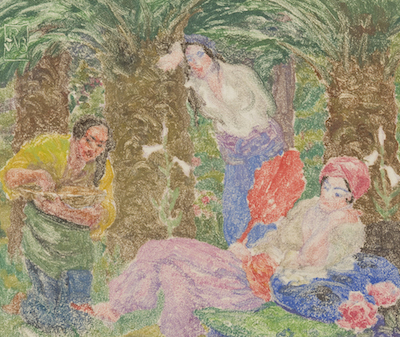Scene Orientaliste
Rupert Bunny

Details
- Artist
- Rupert Bunny
- Title
- Scene Orientaliste
- Year
- c.1921
- Medium
- monotype
- Size
- 25 x 24.5 cm
- Details
signed with monogram upper left
- Stock Number
- 218076
Provenance
commissioned by Galeries Georges Petit, Paris, 1920
private collection, Normandie
Exhibited
Probably, Exposition Rupert Bunny: Monotypes, Galeries Georges Petit, Paris, 16 - 31 March 1921
Probably, Exposition de Monotypes par Rupert Bunny, Galeries Georges Petit, Paris, 16 - 30 October 1924
Literature
See Thomas, David, The Life and Art of Rupert Bunny, A Catalogue Raisonne, Vol 1, Thames & Hudson, Melbourne, 2017, pp. 174 - 192
Further Information
“In 1920 Georges Petit commissioned Bunny to do one hundred colour monotypes. The popularity of Bunny’s mythologies would seem to have influenced him, as they were devoted almost entirely to the same subjects as his paintings – bacchantes and bacchanals, the harem and gods and goddesses of ancient Greece and Rome. The colourful scenes are often laden with riotous movement and oriental fascination. It was a significant commission, for Petit was the head of one of the leading galleries in Paris, An exhibition of sixty-five of Bunny’s individual and colourful monotypes opened at Petit’s in March 1921.
The immediacy of technique, with its limitations of modeling and overall decorative flatness was ideally suited to Bunny’s late style. Le Temps introduced Bunny as the Australia artist ‘who for more than twenty years has been one of us’, its critic describing the monotypes as ‘most pleasing to the eye’.
“In these one hundred compositions, Bunny has almost exclusively produced images drawn from mythology and has treated them in a sense reminiscent of the paintings of Greek vases. They are bathing nymphs, Baccanalian dancers, abductions of Psyche, idylls. They are also scenes from Oriental settings, and through-out the nude dominates, interpreted with an overall breadth, combined with arabesques of gently rhythmic grace, that highlight the beautiful accents of a colour which is always rich and harmonious.”
…
“I am doing a show of rich decorative and even fantastic compositions. Not having touched a brush for so long during the war, I came to the conclusions that painting should be as rich and beautiful as embroideries and oriental stuff; and that the artist has the right to subjective work when he feels like it. In any case, I am just letting myself of and giving my imagination and sense of colour a free range.” ”
(as quoted in Art and Australia, Sydney Feb 1921 p. 41)
Thomas, David, The Life and Art of Rupert Bunny, A Catalogue Raisonne, Vol 1, Thames & Hudson, Melbourne, 2017, pp. 174 - 192
